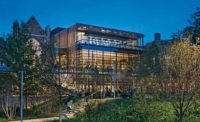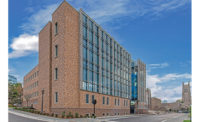Duke University's Environment Hall Will Aid Sustainability Research
A space that was once a parking lot now houses one of the most energy-efficient, eco-friendly buildings on Duke University's campus. A fitting home to the Nicholas School of the Environment, the five-story, 70,000-sq-ft Environment Hall is designed to be the first programmatic building on the Durham, N.C., campus to achieve LEED-Platinum status. Housing classrooms, laboratories, offices and computer labs, the sustainable building features a green roof, solar hot water and photovoltaic systems, a 25,000-gallon rainwater-harvesting cistern for irrigation, a 12,000-gallon gray-water-harvesting tank, a 4,000-sq-ft green roof and a chilled beam system for air conditioning.


Efforts to reduce the project's local impacts included using signage and operator training to curtail unnecessary truck and equipment idling, a major source of community complaint. Also, concrete wash-off water was treated before being discharged in an effort to protect neighboring water bodies.
With a constrained project site and rigid safety requirements, the concrete scope of work required significant upfront planning. Concrete firm Lithko Contracting introduced Lend Lease to the Tabla formwork and shoring system, which met the perimeter fall-protection requirements and eliminated fall exposure.
Duke's Environment Hall will function as a living laboratory where students and faculty, using an energy-monitoring and management system, explore how human behavior can be effectively aligned with technology to boost building performance and occupant productivity. It also will serve as the school's new "front door," employing low-energy building systems aimed at reducing the project's environmental impact. These systems will result in 66% less energy use, a 70% reduction in water use from code and a 41% reduction in water use from harvesting rainwater. Also, 90% of the building is lit by daylight, and 20% of building materials come from recycled content.
Best Green Project — Duke University Environment Hall, Durham, N.C.
Key Players
Contractor Lend Lease (US) Construction, Durham, N.C.
Owner Duke University, Durham, N.C.
Architect Payette Associates, Boston
Structural Engineer Simpson Gumpertz & Heger, Waltham, Mass.
Civil Engineer Stewart, Durham, N.C.
MEP Engineer R.G. Vanderwell, Boston
Sustainability/Building Envelope Engineer Arup, New York




